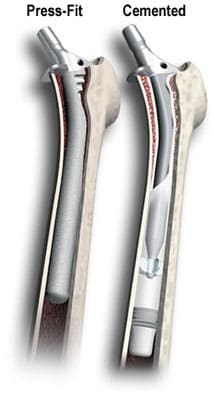Hip Replacement – Which Implant?
Having a hip replacement is a big decision. You not only have to think about the operation and immediate post-operative recovery, but also the longer term effects.
There are approximately 160,000 Hip replacement operations carried out in England and Wales every year so are common practice for most Hip Surgeons, however each replacement done should be tailored to the patient and their needs.
Although hip replacement surgery has advanced with the times (as with most medical procedures) there may still be restrictions on you years after having a hip replacement. Different people need different implants – for example based on their age and activity levels – and making sure that your surgeon discusses this with you and chooses the implant best for you will go a long way in ensuring the best outcome is achieved.
There are numerous manufacturers of Hip Implants who have different types of implants available and Surgeons will have a preference to the type of implant (and the company) that they use and most will vary the implants according to the type of patient that they are operating on (for example based on their bone quality and what their level of function is).
There are generally two ways in which the implant can be fixed to your bone;
- They can be ‘glued’ using cement – this is known as a cemented implant
- They can be coated in a material that bonds with the bone and encourages the bone to grow into it – this is known as an un-cemented (or press-fit) implant.
Commonly, a combination of the two will be used where one component is cemented and the other is un-cemented. This is known as a Hybrid Hip replacement.

Un-cemented implants are favourable when the bone quality is better (in some younger patients) and cemented when the bone quality is poorer.
Another variable to be considered is the bearing surface. A hip replacement produces wear when a patient walks and therefore using a material that produces less debris from movement will wear less.
Common bearing surfaces are:
- Metal on Plastic (MOP)
- Ceramic on Plastic (COP)
- Ceramic on Ceramic (COC)
The plastic used is a high-grade polyethylene that is very durable
Metal on Metal (MOM) implants are now rarely used – if you would like to find out more you can read our post about them here
Then National Joint Registry (who are responsible for collecting information on joint replacement surgery and monitoring the performance of implants) also has some useful information on their website which you can find here.
Your surgeon will know which implant is best for you. If you have any uncertainties then you should make sure you ask questions until you are satisfied that you have all the information you require.